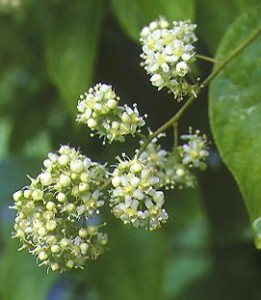My parents arrived safe and sound earlier this afternoon. After the long flight from Boston to Florence (via Zurich), though, they needed a rest. The cats are resting with them (sooo cute!), so I thought I would quickly check my messages and write a brief post.
In the June 15 “Blood” Table of Contents I came across a study on parthenolide by Craig Jordan, Monica Guzman and the University of Rochester/University of Pennsylvania team. As you can read in the abstract (see: http://tinyurl.com/4v2re6), the team discovered not one but two (!) new agents, celastrol and 4-hydroxy-2-nonenal, that effectively eradicate AML at the bulk, progenitor, and stem cell level. Wowie!
I don’t have a lot of time now, and, besides, I don’t have access (yet) to the full study, but just for the heck of it I quickly looked up celastrol, which turns out to be an active antioxidant compound extracted from the root bark of a Chinese perennial plant called  “Thunder of God Vine.” (Don’t you love that name?)
“Thunder of God Vine.” (Don’t you love that name?)
You can read a bit more about it in this 2006 study published in “Cancer Research”: http://tinyurl.com/3l7js6 But, in a nutshell, it has been used for a long time in traditional Chinese medicine to treat inflammatory conditions. It is a proteasome inhibitor (like Velcade) but with no toxic side effects. As far as nude mice are concerned, at any rate! Interesting titbit: I read that its leaves and flowers are highly toxic. I suppose that rules out any possibility of making any thunderous cancer-stem-cell-killing tea, huh?
Well, still, a very exciting bit of news. And my parents are here to share it with me. ![]() I have quite a bit of research in my future, that much is clear!
I have quite a bit of research in my future, that much is clear!
ciao, i found following Side Effects and Cautions
* Thunder god vine can cause severe side effects and can be poisonous if it is not carefully extracted from the skinned root. Other parts of the plant-including the leaves, flowers, and skin of the root-are highly poisonous and can cause death.
* The extract of thunder god vine used in the NIAMS study was well tolerated. However, thunder god vine can cause diarrhea, upset stomach, hair loss, headache, menstrual changes, and skin rash.
* Thunder god vine has been found to decrease bone mineral density in women who take the herb for 5 years or longer. This side effect may be of particular concern to women who have osteoporosis or are at risk for the condition.
* Thunder god vine decreases sperm count and so may be associated with male infertility.
* Tell your health care providers about any complementary and alternative practices you use. Give them a full picture of what you do to manage your health. This will help ensure coordinated and safe care.
Buon Giorno Margaret!
I am an RN and Information Scientist (MIS) with BA in Biology who does research on novel adjuvant cancer therapies. I like to think of myself as a “medical archaeologist” since i also love archaeology. I just came upon your fascinating, indepth site. Kudos! I was about to write you about Honokiol (which i am impressed with for MM) but i see you’ve already discovered it. Stupende! You are a terrific science writer and researcher. I find it hard to believe you are an English major teaching English in Firenze and not a biology professor! I sure wish you could buy 95% Honokiol as a supplement or in bulk/retail or wholesale from China in 25KG drums. Drat! I’ve only been able to find it available as 2% magnolia bark extract on a US website. It seems so much of the really fantastic stuff is only available to researchers or wholesale.
Also, Have you tried mixing your curcumin in organic coconut milk. Makes it go straight into the lymph and bypass the liver. Plus the MCT lauric acid in coconut milk is apoptotic all by itself and it carries the curcumin directly thru the cell lipid membrane via passive transport (normally fats have to be transported using ATP-active transport. A plus).
Tanti auguri e buona fortuna con la tua Mieloma.
Ciao!
Linda Giovanna Zambanini, RN, MIS
lzambeni@alumni.indiana.edu
Bloomington, IN USA
PS sei cosi`fortunata di abitare in italia! Magari!
Ooops…i see a typo…i meant to say: “I sure wish you could buy 95% Honokiol as a supplement in capsules or in bulk (retail). Unfortunately its only available wholesale from China in 25KG drums.
BTW have a great time with your parents who are visiting!
Ciao Linda and everyone,
Yes, I have indeed tried curcumin powder mixed with heated organic (no sugar) coconut milk. I drank that mixture for several months in 2006. I had to stop when I got nauseous just by catching the slightest whiff of that concoction heating up on the stove.
I wrote a post about coconut milk recently; specifically about one of its compounds, kinetin riboside, that has anti-mm cell activities. As soon as I can stand the smell of heated coconut milk again, I will go for it! Good stuff, you are right!
What you say about honokiol is true of other compounds, too (as you yourself point out). Another good example would be cyclopamine, extracted from corn lilies, a substance that kills leukemic stem cells. I would love to try that but it is too expensive (another problem!) and hard to obtain. Some day…I hope!
Just thought I would end by mentioning that I am not an English major. My BA is in Social Anthropology (favourite subject: archaeology, by the way!); MA in Italian lang and lit; Ph.D. in Romance langs and lits.
Thanks for your kind comments. Good luck on your medical digging, and please keep in touch!
And thanks, Roberto, for that list of side effects. Good to know!
Ciao a tutti!
Margaret 🙂